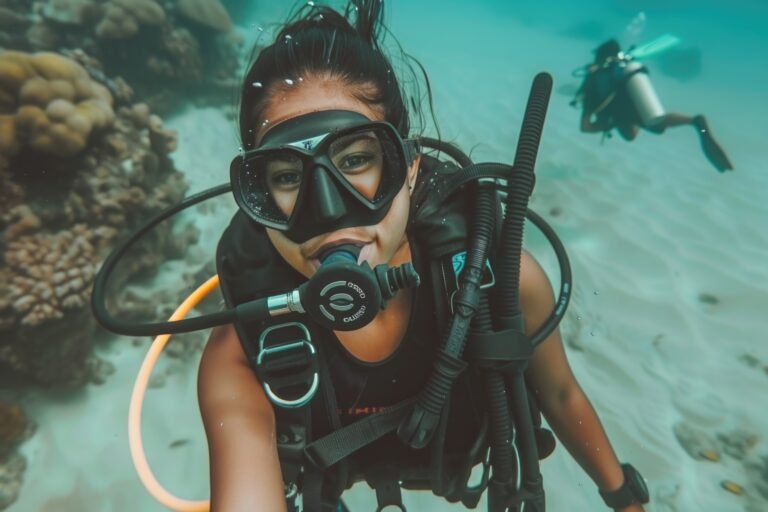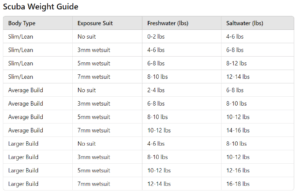5 Tips to Achieve Neutral Buoyancy When Scuba Diving

Whether you’re new to diving or you’re an old pro, there’s one thing you’re likely to struggle with: buoyancy. The goal for scuba divers is to achieve neutral buoyancy, allowing them to float weightlessly in the water, without rising up or sinking down. Achieving neutral buoyancy is essential for safe, efficient, and enjoyable scuba diving. It allows you to hover effortlessly in the water, protecting marine life and reducing air consumption. Mastering buoyancy control can take time, but these five tips will help you improve your skills and make your underwater experience more comfortable. Peak buoyancy will make your dive easier. You’ll use less energy, which means less air consumption, longer dives, and feeling less tired after your dive.
A wide range of factors contribute to buoyancy—diving depth, wetsuit thickness, body mass and more. So how do you achieve the perfect balance for neutral buoyancy? Here’s what you need to know.
THE 3 ELEMENTS OF BUOYANCY CONTROL
Neutral buoyancy is managed by three main elements: the buoyancy control device (BCD), diving weights, and lung volume.
-
The Buoyancy Control Device (BCD)
The BCD is your primary tool for adjusting buoyancy. This special vest contains inflatable bladders that can be inflated or deflated to help you maintain your desired position underwater. By adding air, you’ll become more buoyant and rise in the water column, while releasing air will make you sink. Make small, precise adjustments to your BCD to fine-tune your buoyancy throughout the dive.
-
Diving Weights
Weights help to counteract your natural buoyancy, allowing you to descend more easily. These weights come in various forms, such as lead weights, weighted belts, or harnesses, and they provide the extra force needed to reach and stay at depth. Finding the right amount of weight is key to achieving neutral buoyancy. Too much weight will make it hard to ascend, while too little will cause you to float uncontrollably.
-
Lung Volume
Your breathing plays a bigger role in buoyancy than many divers realize. Air naturally wants to rise, and your lungs can create up to 10 pounds of buoyancy when fully inflated. By taking slow, controlled breaths, you can make small adjustments to your position without touching your BCD. Breathing in deeply will lift you slightly, while exhaling will cause you to sink a bit. Practicing steady, calm breathing will help you stay neutrally buoyant.
5 TIPS TO ACHIEVE NEUTRAL BUOYANCY WHEN SCUBA DIVING
-
Choose the Right Amount of Weights
One of the most important steps to achieving neutral buoyancy is selecting the correct amount of weights for your dive. Start by doing a buoyancy check: with an empty BCD and normal breath, you should float at eye level on the surface. Adjust your weights until you feel balanced—enough to descend but not so much that you’re sinking uncontrollably. As you gain experience, you’ll get a better feel for how much weight you need based on factors like your exposure suit, water type (saltwater or freshwater), and the type of gear you’re using.
-
Fine-Tune Your Breathing
Your lungs act as a natural buoyancy control device. By controlling your breathing, you can make small adjustments to your depth without touching your BCD. Taking a deep breath will make you rise slightly, while exhaling will help you sink. Practice slow, controlled breathing to maintain a stable position in the water. This technique is especially useful when hovering near delicate marine environments like coral reefs.
-
Make Precise BCD Adjustments
Use your BCD to fine-tune your buoyancy throughout the dive. A common mistake is adding too much air to the BCD at once. Instead, add small bursts of air until you feel balanced. The same applies when deflating it—release air slowly to avoid drastic changes. This will give you better control and help you maintain neutral buoyancy with minimal effort.
-
Adjust for Depth Changes
As you descend, the water pressure increases, compressing your wetsuit and decreasing your buoyancy. Conversely, as you ascend, your wetsuit expands, making you more buoyant. To stay neutrally buoyant, you’ll need to adjust your BCD and your breathing as you move through different depths. Make sure to ascend and descend slowly to give yourself time to make these adjustments.
-
Practice and Be Patient
Mastering neutral buoyancy takes time and practice. The more dives you do, the more intuitive buoyancy control becomes. Every dive environment is different, whether it’s freshwater, saltwater, or varying equipment setups, so keep practicing and refining your skills. Many divers find that taking a buoyancy control course helps them gain confidence and improve their abilities more quickly.
BETTERING YOUR BUOYANCY
While these tips can help level out your buoyancy, keep in mind that no two dives are the same. You may need very different weights, breathing tactics or BC usage depending on dive location, equipment or even physical health. By staying in tune with your body and being patient, you’ll be able to attain the weightless dive you’ve been “weighting” for.
PICKING THE RIGHT AMOUNT OF WEIGHT
- Buoyancy Check: At the surface, with a fully deflated BCD and a normal breath, you should float at eye level. Add or subtract weights until you feel balanced.
- Saltwater vs Freshwater: Saltwater is more buoyant, so you’ll need 4-6 lbs more than you would in freshwater.
- Exposure Suit: Thicker wetsuits (like 5mm or 7mm) require more weight since neoprene provides more buoyancy.
- Gear Considerations: Certain gear like steel tanks are negatively buoyant, meaning you may need less weight than if using aluminum tanks.

This grid serves as a starting point, and divers should perform buoyancy checks at the start of each dive to fine-tune their weights based on personal experience and conditions.
